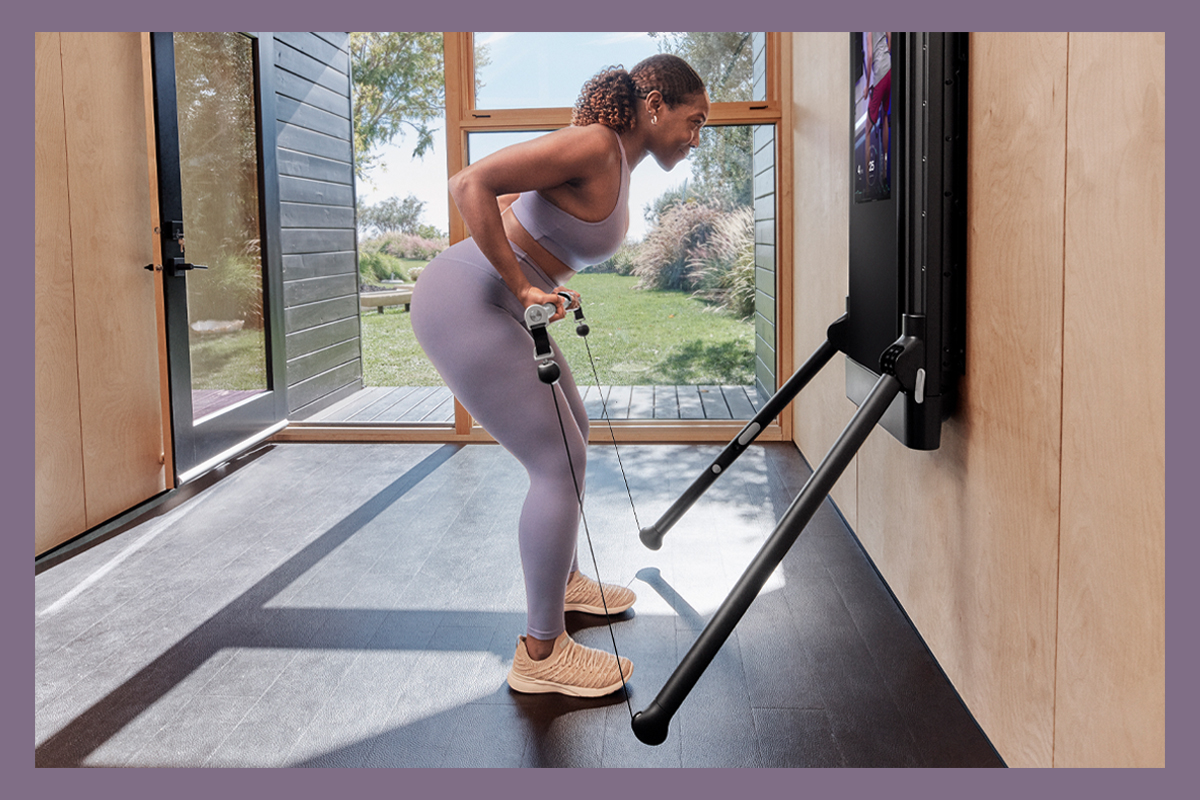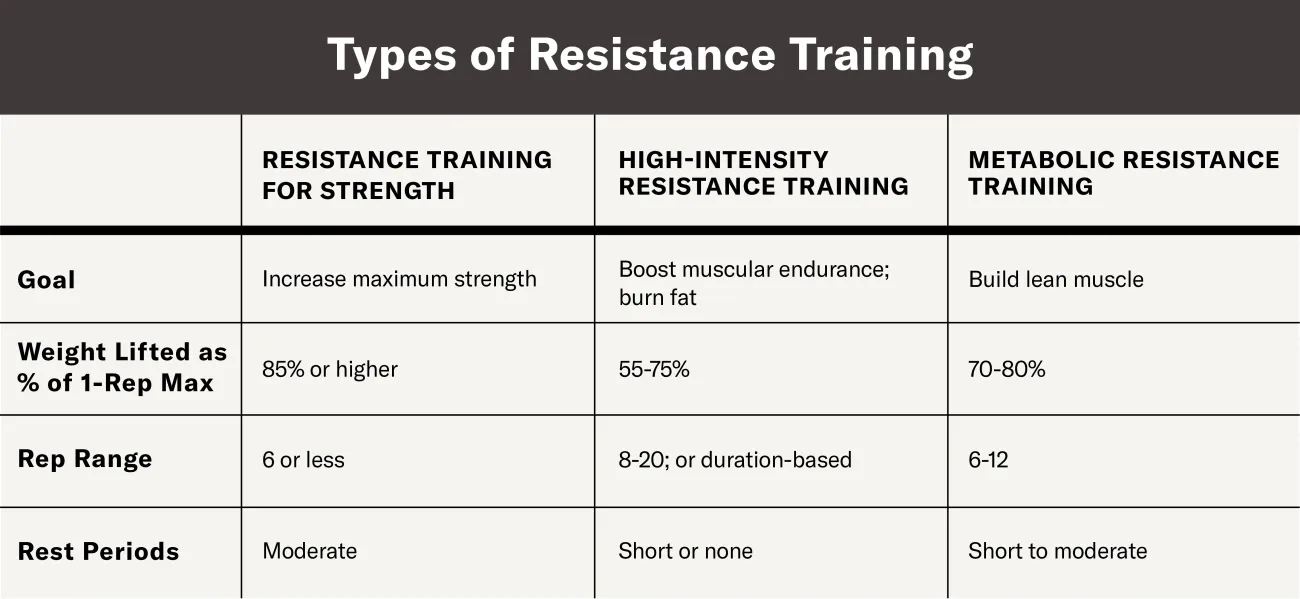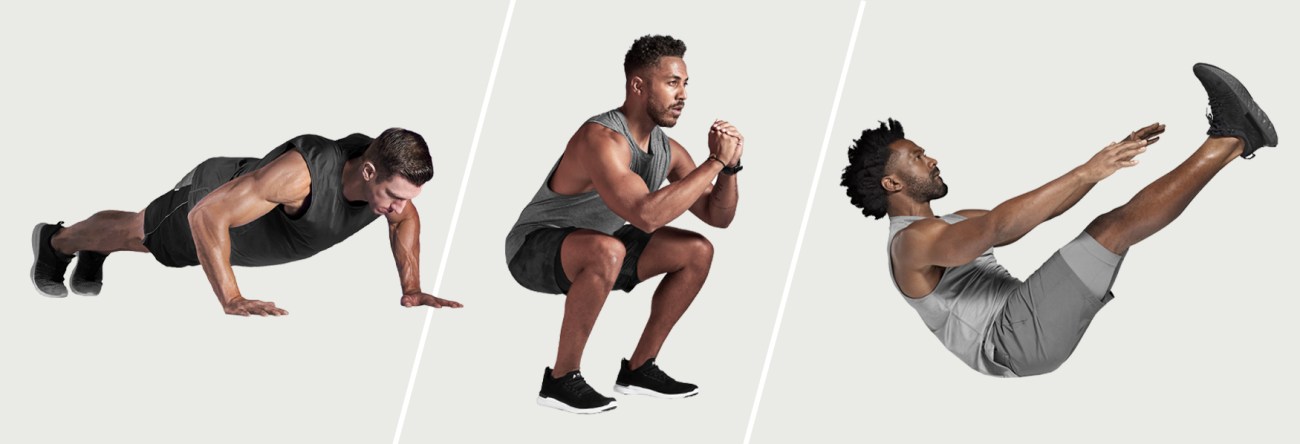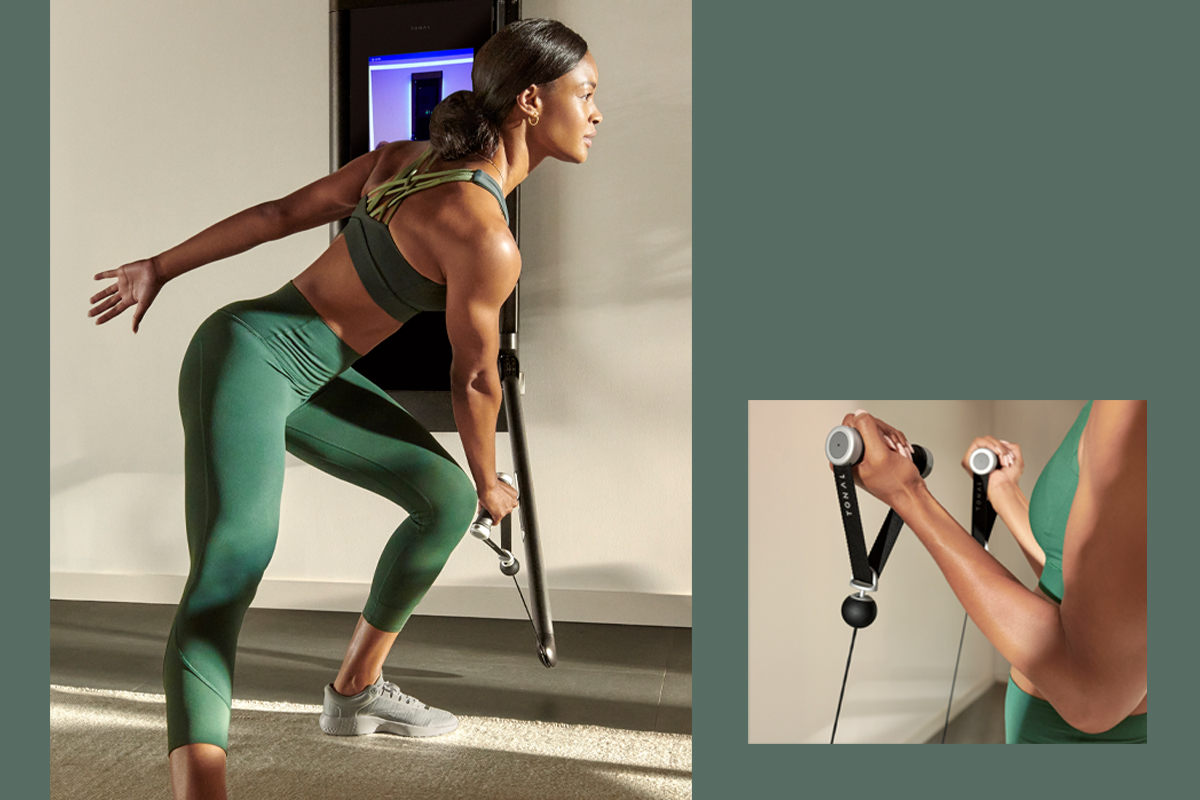Here’s everything you need to know about this highly-effective exercise method.

Resistance training—also known as strength training—isn’t just for bodybuilders looking to grow massive muscles. With benefits including better quality sleep, weight loss, stronger bones, and a reduced risk of injury and illness, resistance training is truly for everyone.
Gaining strength can also be a big confidence booster. As Tonal coach and certified personal trainer Ash Wilking says, “When we look in the mirror and feel strong, that allows us to see ourselves in a different way.”
You don’t have to spend hours in the gym to reap the rewards, either. The CDC recommends a minimum of two full-body strength training sessions per week. Yet in a recent study of more than 400,000 adults, 76 percent of participants reported that they don’t do any resistance training.
But here’s the good news: Even if you fall into that category, it’s never too late to get started. Skipping out on strength puts you at risk of chronic illness and injury, especially as you age. Read on to learn more about the different types of resistance training and how you can use them to achieve your goals.
What is Resistance Training?
Resistance training is any exercise that increases muscular strength and endurance by exposing muscles to external demand.
“It could be dumbbells, kettlebells, Tonal, barbells—any external stimulus on the muscle as you’re taking it through the contraction pattern,” says Christian Hartford, Performance Manager of Applied Sports Science at Tonal.
Resistance training differs from cardiovascular exercises such as running or cycling, which raise your heart rate and respiration through rhythmic, continuous motions. Because cardio exercise is essential for maintaining a healthy circulatory system, it’s worth doing in addition to resistance training. In fact, for healthy weight loss in which you lose fat and maintain lean muscle, cardio and strength training are a perfect pairing. As you’ll see below, though, there are ways to combine both forms of exercise in the same workout.
What are the Benefits of Resistance Training?
While you’ll certainly build muscle and get stronger by adding resistance training to your weekly routine, the benefits go far beyond perfecting your physique.
Better sleep: In one recent study, subjects who participated in resistance training were able to sleep longer each night over the course of a year than those who do aerobic exercise. Another study showed that any amount of resistance training (regardless of intensity level) can improve sleep quality.
Mood boost: Multiple studies have shown that resistance training can relieve symptoms of depression and anxiety. Tackling tough workouts and making strength training a habit fosters feelings of competency that will trickle into other areas of your life.
“You’re keeping promises to yourself which builds confidence,” says Joe Rodonis, Tonal coach and certified personal trainer. “You’re saying, I’m going to do this, and you’re honoring it.”
Weight loss: Resistance training can improve your body composition by increasing lean muscle mass and reducing fat. A meta-analysis of 58 studies revealed that strength training can reduce body fat percentage, body fat mass, and visceral fat. This strategy certainly worked for Tonal member Robert Mahaney. By combining resistance training with diet changes and aerobic exercise, Mahaney lost 100 pounds and got his diabetes under control.
Stronger bones: As we age, our bones lose density which can lead to osteoporosis, in which bones become weak, brittle, and prone to breaking. Resistance training can slow this process by forcing bones to adapt to stress, which has been shown to preserve bone mass.
Healthy aging: Resistance training helps you live longer and helps you enjoy those extra years. A meta-analysis of studies that looked at more than 2 million adults linked strength training to a 14-percent lower risk of all causes of death. Another large review showed strength training improves functional movement, which allows you to stay active as you age. Take Tonal member Tracy Dingman, for example. At 65, she’s hiking mountains around the world and has no plans to slow down.
Improved sports performance: Whether you play golf, swim laps, or run marathons, strength training can boost your power and agility in other sports and make your body more resilient against sports injuries. That’s why athletes ranging from hobby golfers to LeBron James make resistance training part of their regular routines.
Reduced risk of illness and injuries: Strength training has been linked to a reduced risk of type 2 diabetes and cardiovascular disease and has been shown to lower chronic inflammation. By improving the strength of the muscles and tendons that support your joints, resistance training protects against overuse injuries. It can even prevent debilitating falls by building coordination, balance, and flexibility.
Does Resistance Training Burn Fat?
Cardio exercise tends to come to mind when we think about burning calories, but resistance training is very effective at reducing fat through several mechanisms.
During steady-state cardio exercise, your heart rate typically remains in Zone 2 or Zone 3 (or 60 to 80 percent of your maximum heart rate) throughout the workout. While you’ll burn calories doing exercise of any intensity, in these aerobic zones your body primarily uses fat as fuel.
During resistance training, your heart rate might spike during a set and then come back down during your rest period, but your average heart rate throughout a workout will generally fall into Zones 2 or 3. “You’re actually spending time in similar heart rate zones as what you would think about for fat-burning cardio,” says Hartford.
As you build lean muscle, you’ll increase your resting metabolic rate–the number of calories your body burns while at rest–because muscle is a major calorie burner. “Through resistance training, you change your body composition,” says Hartford. “By adding lean muscle, you get the metabolic effect, which results in a decrease in fat.
Some resistance training workouts incorporate a cardio component through high-intensity intervals with minimal rest periods. These sessions combine the fat-burning benefits of both cardio and resistance training.
These workouts, in particular, are especially effective in stimulating excess post-exercise oxygen consumption (EPOC), or the “afterburn effect,” in which your body burns more calories following a hard workout. “After intense exercise, your body continues to maintain a higher metabolic state where it’s working to replenish the muscles and give the body the energy it needs to recover,” says Hartford.
What are the Different Types of Resistance Training?
There are a few different flavors of resistance training and which one you choose may depend on your current goal. These workouts typically differ in how heavy you lift, how many reps and sets you complete, and how long you’re resting in between sets. While there are more kinds of resistance training than the ones listed below, these are the three that you’ll most likely encounter on Tonal and in most workout settings:

Resistance Training for Strength
The Goal: Although the terms “resistance training” and “strength training” are often used interchangeably, if your goal is to maximize strength, you’ll want to focus on this specific type of resistance training. By training specifically for strength, you’ll build bigger muscles and improve your ability to lift heavier weights.
The Method: According to John Christie, Director of Curriculum at Tonal, you’ll want to lift weights at the upper limits of your strength potential.
Hartford says you’ll typically be lifting 85 percent or higher of your one-rep max for any particular exercise. With these very heavy weights, you’ll usually do no more than 5 or 6 reps in a set, and take long rest periods in between sets.
“You want to make sure that you can lift that 90 percent [of one-rep max] with good technique every single session, so you’re going to take a little bit of longer rest periods to let your body recover.”
How it Feels: When you’re lifting heavy, Hartford explains, the fatigue you feel tends to be more systemic than localized because it’s more taxing on your nervous system. “That’s why it’s important to take that rest in between sets to make sure that you’re not fatiguing the nervous system to a point that puts you at a higher chance of technical failure or injury,” says Hartford.
High-Intensity Resistance Training
The Goal: With an emphasis on high work capacity, this type of training is ideal for improving muscular endurance and burning fat.
The Method: Compared to resistance training for strength, high-intensity resistance training involves lifting lighter weights (Hartford says typically anywhere from 55 to 75 percent of one-rep max) for shorter, more explosive durations with brief rest periods. The focus is maintaining a high workload throughout a workout by continually staying in motion. You might do anywhere from 8 to 20 reps in a single set.
“For high-intensity resistance training we dial the resistance back so you can move at a greater rate of speed,” says Christie. “The rest periods tend to be shorter or non-existent.”
These workouts often feature circuits in which you’ll work through two or three exercises several times. The focus is on speed and staying in motion, so you may train for time instead of reps in these workouts; for example, completing as many reps as you can for 30 seconds.
How it Feels: Because the weight is a little lower in high-intensity training, it won’t feel as taxing on a per-set basis as resistance training for strength, but you’ll be dealing with accumulated fatigue by the end of the workout. Since you’re repeating a single exercise many times, it’s common to feel a localized “burn” (think about how your quads feel during a round of jump squats) within a muscle group in high-intensity training. This type of training is more demanding to your cardiovascular system so you’ll feel your heart working hard and you may be out of breath by the end of a set.
Metabolic Resistance Training
The Goal: Like traditional strength training, metabolic resistance training involves building muscle (or hypertrophy), but the focus is on improving body composition by increasing lean muscle and decreasing fat. Through metabolic resistance training, Christie says you’ll “develop the lean muscle mass that then works to increase your metabolic rate.”
The Method: In metabolic resistance training, you’ll likely be working in the 8 to 10-rep range with rest periods longer than the ones in high-intensity training but shorter than in resistance training for strength. As Hartford explains, “These rep ranges and intensity levels are going to result in an increase in lean muscle mass at a rate or pace that will result in fat burning.”
How it Feels: Hartford describes metabolic resistance training as a “happy medium” between resistance training for strength and high-intensity resistance training. You’ll finish these workouts feeling a “pump” in your muscles but not so fatigued that you can’t imagine doing one more rep.
How Can You Do Resistance Training at Home?
You don’t have to go to the gym to enjoy the benefits of resistance training. Try one of the options below to build strength at home.

Bodyweight Resistance Training
If you’ve ever done pushups, crunches, or pull-ups, you know it’s possible to get a challenging resistance training workout done using only your body weight. Bodyweight workouts require no equipment and can be done anywhere so they’re an excellent option when you’re traveling or getting started with resistance training. As you get stronger, though, you’ll eventually need additional resistance in the form of external weight to keep giving your muscles the necessary stimulus to grow.
Free Weight Resistance Training
With free weights—which include dumbbells, kettlebells, and barbells—you can challenge your muscles more than with body weight alone. Adding equipment opens up the range of exercises you can complete and the ability to gradually lift heavier weights ensures your strength will progress. One downside of training with weights is that because dumbbells are often only available in certain weight increments, it can be challenging for beginners to do new exercises when they aren’t ready for a large weight increase.
Smart Home Gym Resistance Training on Tonal
Sleek and space-saving, Tonal combines the weight of dozens of free weights into a single all-in-one smart home gym. With the ability to increase resistance in one-pound increments, it’s easy to gradually build your strength. Tonal’s adjustable arms allow you to do exercises that aren’t possible with dumbbells by changing the direction of resistance. Through an electromagnetic digital weight system that can change the resistance within a set or a single rep, Tonal offers dynamic weight modes like Chains, Burnout, or Eccentric that add challenge to your workouts.
On Tonal, you’ll get personalized weight recommendations for every exercise at every rep range. There’s no need to find your one-rep max (which can be potentially dangerous without a spotter) and then calculate specific percentages of that number. Tonal also offers programs and workouts that feature the different types of resistance training listed above so you can achieve your goals with expert guidance. Tonal keeps track of all your stats for you and continually pushes your limits as you get stronger.


